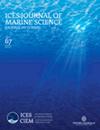An Eulerian perspective on habitat models of striped bass occurrence in an offshore wind development area
IF 3.4
2区 农林科学
Q1 FISHERIES
引用次数: 0
Abstract
Offshore wind energy development, including along the US Atlantic coast, frequently occurs within important multispecies migration corridors; however, assessing the regional factors influencing the local Eulerian occurrence of these species poses a significant challenge. We used generalized models incorporating lagged variables and hierarchical formulations to account for temporal dependencies and hierarchical structure that occur outside the narrower frame of a sampled project area. Acoustically tagged striped bass, the most frequently detected species regionally, were sampled using a gridded acoustic telemetry array in the Maryland Wind Energy Area of the US Mid-Atlantic Bight. The daily occurrence of striped bass was better explained by broad-scale sea surface temperature warming patterns than by local concurrent environmental conditions, demonstrating the importance of drivers that occur across the wider spatial scales of migration. Weekly residency patterns were similar between tagging origin groups, suggesting that Chesapeake Bay, Hudson River, Delaware Bay, and other Northwest Atlantic populations migrate synchronously through the Southern Mid-Atlantic Bight and are similarly influenced by sea surface temperature. Our study demonstrates that adapting an Eulerian approach to include lagged variables can improve regional assessments of fish on the move until richer Lagrangian insights become possible through future coordination of telemetry arrays throughout the Mid-Atlantic flyway.从欧拉角度看近海风电开发区带鱼的栖息地模型
包括美国大西洋沿岸在内的近海风能开发经常发生在重要的多物种迁徙走廊内;然而,评估影响这些物种在当地欧拉发生的区域因素是一项重大挑战。我们使用了包含滞后变量和分级公式的广义模型,以考虑在采样项目区狭小范围之外出现的时间依赖性和分级结构。在美国大西洋中部海湾的马里兰风能区,使用网格声学遥测阵列对区域内最常检测到的物种--声学标记的带鱼进行了采样。大尺度海面温度升高模式比当地同时出现的环境条件更能解释带鱼每天的活动情况,这表明在更大的迁移空间尺度上发生的驱动因素非常重要。不同标记来源组之间的每周驻留模式相似,这表明切萨皮克湾、哈德逊河、特拉华湾和其他西北大西洋种群通过南大西洋中部海湾同步迁徙,同样受到海表温度的影响。我们的研究表明,在未来通过协调整个中大西洋航道的遥测阵列而获得更丰富的拉格朗日见解之前,调整欧拉方法以纳入滞后变量可以改善对迁徙鱼类的区域评估。
本文章由计算机程序翻译,如有差异,请以英文原文为准。
求助全文
约1分钟内获得全文
求助全文
来源期刊

ICES Journal of Marine Science
农林科学-海洋学
CiteScore
6.60
自引率
12.10%
发文量
207
审稿时长
6-16 weeks
期刊介绍:
The ICES Journal of Marine Science publishes original articles, opinion essays (“Food for Thought”), visions for the future (“Quo Vadimus”), and critical reviews that contribute to our scientific understanding of marine systems and the impact of human activities on them. The Journal also serves as a foundation for scientific advice across the broad spectrum of management and conservation issues related to the marine environment. Oceanography (e.g. productivity-determining processes), marine habitats, living resources, and related topics constitute the key elements of papers considered for publication. This includes economic, social, and public administration studies to the extent that they are directly related to management of the seas and are of general interest to marine scientists. Integrated studies that bridge gaps between traditional disciplines are particularly welcome.
 求助内容:
求助内容: 应助结果提醒方式:
应助结果提醒方式:


